
 |
|
 |

 |
|
 |
| 05-31-2013, 02:07 AM | #134 |
|
coupe la goon

373
Rep 1,645
Posts
Drives: green, black, white
Join Date: Jan 2006
Location: pdx
iTrader: (26)
Garage List 2011 BMW 1M Coupe [10.00]
2013 BMW M3 Coupe [10.00] 2010 BMW 535i xDriv ... [0.00] 2008 BMW M3 Coupe ( ... [0.00] |
Oh good heavens! Please, please start a new thread with the information you just posted!
|
|
Appreciate
0
|
| 05-31-2013, 02:54 AM | #135 | |
|
Captain
    
90
Rep 850
Posts |
Quote:
And to the people who spread negative things please just be patient. First of, the price. Positive displacement kits usually cost more than centrifugals. Secondly, being late doesn't mean anything. Check out Cobb in N54 part of this forum. Last one to jump in the party, now it's the most common tune(I know it's a flash and others are piggy). And lastly, let's keep the debates for when it's fully released then come and talk how dangerous it is to push X PSI on stock bearings. We don't know what amount of boost we are going to deal with. HPP-M3 Welcome. I'm a big fan of your approch to this system. People here seem to overlook what you've achieved and how hard it is to find a way to deal with the individual throttle bodies. Your by-pass valve method is very innovating and opens doors to all other S engines (I love the idea of having a big PD SC'd S85 with your design). |
|
|
Appreciate
0
|
| 05-31-2013, 03:17 AM | #136 | |
|
Grease Monkey

295
Rep 2,646
Posts
Drives: 2011 E90 M3,1994 Euro E36 M3/4
Join Date: Apr 2006
Location: Fort McMurray, Alberta, Canada
|
Quote:
I am extremely excited to hear more about this supercharger as development continues and I am extremely confident that it will work great! The combination of an Eaton TVS SC unit and electronic bypass setup has been and still is being proven in real world use on hundreds of thousands of Audi's running around every day! |
|
|
Appreciate
0
|
| 05-31-2013, 04:31 AM | #137 | |
|
Captain
    
90
Rep 850
Posts |
Quote:
|
|
|
Appreciate
0
|
| 05-31-2013, 11:37 AM | #138 | |
|
Lieutenant
   34
Rep 454
Posts
Drives: :O
Join Date: Jan 2013
Location: Scottsdale
|
Quote:
Agreed, but those in the market for a positive displacement supercharger like this one are probably not in the road course scene. Higher likelihood that they'll be a daily driver, stoplight drag racers. I have a C32 AMG, which is a positive displacement supercharged motor. I have to say that it's a lot of fun in the city compared to my supercharged M3, and it feels quicker in these instances when I'm not revving it out. That doesn't make the car better overall, but for people that drive the cars daily, it does make it more enjoyable in the conditions spent most often. I do agree that it would seem to take away from the natural characteristics of the motor and turn it into something it wasn't designed to feel like. |
|
|
Appreciate
0
|
| 05-31-2013, 12:02 PM | #139 | |
|
Lieutenant
   
39
Rep 529
Posts |
Quote:
Either way, congrats Harrop on the new kit! I wish you nothing but success!
__________________
2014 Porsche 911 Turbo S - FOR SALE
2010 BMW M3 (e90) - SOLD 2005 Corvette C6 - SOLD |
|
|
Appreciate
0
|
| 05-31-2013, 01:16 PM | #141 |
|
Major
 197
Rep 1,231
Posts |

__________________
|
|
Appreciate
0
|
| 05-31-2013, 01:27 PM | #142 | |
|
BimmerPost Supporting Vendor

3391
Rep 7,543
Posts  |
Quote:
Bubu probably thinks that 9-11 was launched by the US presidential office: http://www.m3post.com/forums/showthread.php?t=847261 I think people need to give RESPECT to Harrop for what they've done so far, regardless if the tuning is complete or not. Why doubt a respected company that has produced many successful applications without any base to do so? Keep up the good work Heath and Jonathan. Our first interaction with Harrop was back in April of 2012 and we performed some race seat coding for them on a car in Australlia. It was a pleasure meeting them in person @ Bimmerfest.
__________________
 -----| Like us on Facebook | Instagram || Tuning Information | Remote Coding |----- ----Visit us at www.BPMSport.com - Emotion. Driven. | Toll Free: (888) 557-5133---- |
|
|
Appreciate
0
|
| 05-31-2013, 01:52 PM | #143 |
|
Bunny Slayer

83
Rep 501
Posts
Drives: E92 M3 - DCT (2013)
Join Date: Apr 2010
Location: Orange County - Southern California
|
I'm excited about the kit and will probably end up running it once its proven out. I'm a big fan of down-low torque, and that's certainly what this kit will deliver.
With that said, I don't want my motor to be a guinea pig  , then again who does. , then again who does. |
|
Appreciate
0
|
| 05-31-2013, 02:05 PM | #144 | |
|
Lieutenant
   37
Rep 513
Posts |
Quote:
But, who am I to tell someone else what to do with their money? |
|
|
Appreciate
0
|
| 06-01-2013, 06:51 PM | #145 |
|
Enlisted Member
 
2
Rep 32
Posts |
I'm exceptionally excited about this kit, coming from large displacement V8 domestic cars I have been missing my low end grunt, don't get me wrong, I absolutely LOVE my E90 but it could use another 100 ft/lbs of grunt to be a phenomenal car, this chassis is ready for more power

__________________
|
|
Appreciate
0
|
| 06-01-2013, 10:08 PM | #146 |
|
Major General
  1581
Rep 8,077
Posts
Drives: 11 E90 M3 Individual
Join Date: Mar 2006
Location: Houston, TX
|
I had a twinscrew kit on my E46 330 which I tracked. The main advantage is you build peak boost at lower revs so you get more power lower in the rev range. IIRC, boost is based on throttle position. This would be excellent for a 6MT car because you can get good power and not having to downshift. So I think this kit would give the average user more usable power vs a centri kit where you need to run the engine to redline to get to full boost/power.
Not sure if this would be the way I would go for a DCT since it just takes the press of a paddle to get the revs into the sweet spot. What I do like about the heat exchanger is you can get more creative vs an intercooler. I've thought about routing the lines into the cabin and run it through a box chilled with ice. You can also better manage heat soak by using distilled water and water wetter. AND...you can easily increase boost with these TS units up to something like 18psi of course that will be limited by the engine's high compression. The downer is these blowers are way more expensive than a centri blower. The good thing is (at least on my 330) the oil is self contained in the blower. Took 4oz of 10w-60 and I changed it every 15k miles...should be easy with the way the blower is oriented. A total messy PIA in my 330. Here's my twinscrew'd 330 on the track...I think it would sound astonishing on an S65!
__________________
2018 F30 320iX Melbourne Red
2011 E90 M3 Monte Carlo Blue 2004 E46 M3 Imola Red 2000 E36/7 Z3 Steel Blue Last edited by bigjae1976; 06-02-2013 at 06:39 AM.. |
|
Appreciate
0
|
| 06-03-2013, 04:11 PM | #149 |
|
Second Lieutenant
 116
Rep 212
Posts |
After owning a 2008 E90 M3 and then a 2011 E90 M3, I've now switched over to the gen-2 Cadillac CTS-V. It's powered by the GM LSA engine, which also features an Eaton Roots-type TVS1900 supercharger mounted between the cylinder banks. Sounds familiar?
 Ever since going F/I (albeit by changing cars rather than modding), I've done some reading on the various types of S/C, naming Centrifugal (what everyone is using in S65 applications right now), Roots and Twin-Screw. This article is the only one I've found so far that scientifically compares the 3 kinds of superchargers on the same 2003 Mustang Cobra engine: http://www.musclemustangfastfords.co...ced_induction/ Of course, the article was written in 2004 so it pre-dates the Eaton TVS Roots-type, but some comparisons can still be made I guess. From the article: Roots - Cheapest(!?), high boost from low-RPM but tapers off towards redline (hence the bells-shaped torque curve), compresses air against the supercharger housing so produces the most heat, the choice of the OEM.  Which is why it's called Positive Displacement... 556bhp and 551ft.lb. from a 6.2L engine sounds impressive, but when adding the 1.9L from the supercharger unit into it so if you were to consider it as a 8.1L engine (and using fuel as such), then... not so much  Twin-Screw - More expensive, mimics Roots-type with high boost from low-RPM but able to maintain boost at high RPM, compresses air between the screws so produces less heat (which is why it is able to maintain boost at high RPM). Centrifugal - Produces less boost at low-RPM but able to produce more boost at high-RPM, so as in the case of the countless S/Ced M3 dyno charts we have seen, does not improve torque output at low-RPM as much but does massively increase the horsepower rating at the top-end. Eaton TVS - Bridges the gap between the Roots and the Twin-Screw but is still essentially a Roots-type. 3000km and 2 months in with the CTS-V, after 5 years with the M3, here are my thoughts, engine-wise: - There is a boost gauge in the instrument cluster, and it seems like the boosting is still tied into throttle position; as in, the boost gauge doesn't move unless my gas pedal is past a certain point (around half-way). I thought a positive-displacement supercharger is working all the time, but that doesn't seem to be the case. - I had a 335i for a year or so before going onto the M3, so now it's nice to once again be able to accelerate despite being a couple of gears too high. I guess that's the beauty of positive-displacement charger? Despite being in 6th gear, 1500rpm, when you smack the throttle the boost comes on and it still GOES. Mind you, for a DCT M3 it's not that big a deal as it is easier to manage your gears (my 2nd M3 was a M-DCT); I think a previous commenter in this thread said the same thing. - The engine bay is HOT! Water temperature never seems to change much on the dash (idiot gauge, maybe), but after a good drive (like 1hr on the highway to get to the drag strip), the steel engine bay cross-member (which is right above the supercharger) is too hot to touch, while the plastic covers around the electronics are almost too hot to handle. |
|
Appreciate
0
|
| 06-03-2013, 08:53 PM | #150 | |
|
Lieutenant General
   7532
Rep 12,318
Posts |
Quote:
__________________
Current:
16 F82 M4 GTS, Black Sapphire/Black, DCT 08 E92 M3, Sparkling Graphite/Bamboo Beige, 6MT 07 E85 Z4M Roadster, Alpine White/Red, 6MT 99 E36 M3, Techno Violet/Dove Grey, 6MT |
|
|
Appreciate
0
|
| 06-03-2013, 11:35 PM | #151 |
|
BimmerPost Supporting Vendor

3391
Rep 7,543
Posts  |
I've driven the CTS-V and that thing is nothing short of a freaking monster!
__________________
 -----| Like us on Facebook | Instagram || Tuning Information | Remote Coding |----- ----Visit us at www.BPMSport.com - Emotion. Driven. | Toll Free: (888) 557-5133---- |
|
Appreciate
0
|
| 06-04-2013, 07:48 AM | #152 |
|
Lieutenant General
   7532
Rep 12,318
Posts |
If only it was good to look at, but of course looks are subjective.
__________________
Current:
16 F82 M4 GTS, Black Sapphire/Black, DCT 08 E92 M3, Sparkling Graphite/Bamboo Beige, 6MT 07 E85 Z4M Roadster, Alpine White/Red, 6MT 99 E36 M3, Techno Violet/Dove Grey, 6MT |
|
Appreciate
0
|
| 06-04-2013, 09:07 PM | #153 |
|
Second Lieutenant
 116
Rep 212
Posts |
Thanks for the kind (and even not so kind
 ) words about my choice of current ride, but that's kind of a ) words about my choice of current ride, but that's kind of a  so back onto topic.... so back onto topic....First of all, I wanted to point out that since the Harrop kit is using the Eaton TVS, it is a Roots supercharger instead of the Twin-Screw as noted in the title / first post. No fault to the author, as the external housing and connections for both units are very similar (if not the same), but they work quite differently. Second, the heat that built up in my engine bay despite a lowly 6100rpm redline (and a VERY HARD 6200rpm fuel cut-off that bogs for engine for at least half a second) is much more intense than anything I experienced with the M3, so I can't imagine what it would be like for a similar unit in a 8400rpm screamer. I'm sure the designers have taken this into account so it would be interesting to hear what their thoughts are. Thirdly, with early boost that tapers off after producing max torque (due to the heat output) in the GM LSA application, I can imagine the kit to definitely not out-horsepower the current Centrifugal offerings, but definitely out-torque them from any RPM except near redline. "mere" 500bhp max output but over 400ft.lb. available at between 3000-4000rpm?* Basically make the S65 behave like a large NA V8, but without the extra weight penalty and also with the handling of the M3? Given what the C63 AMG has done at the strip and the rolls, that's not so bad is it? *PS, just talking out of my arse there so don't believe those numbers for a single second; it's just an example. |
|
Appreciate
0
|
| 06-11-2013, 08:40 AM | #154 |
|
Second Lieutenant
 
70
Rep 287
Posts |
Info on Roots vs. TVS vs. Twin Screw vs. Centrifugal from Autozine
From Autozine: http://www.autozine.org/technical_sc...duction_1.html
Roots type supercharger 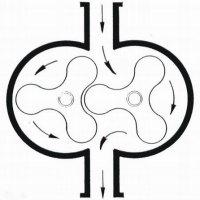 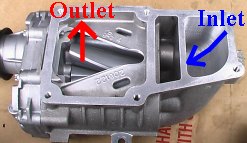 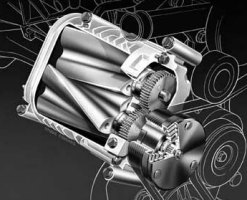 Roots type supercharger is named after its inventor, the Roots brothers. It was invented as an industrial air pump well before Daimler and Benz invented motor cars. Surprisingly, the ancient design is still being used in most numbers today. The Roots supercharger consists of two rotors, usually with 3 lobes each. They rotate in counter direction to pump the air from inlet to outlet (see the first picture). This motion does not compress the air inside the supercharger. However, as the supercharger supplies air faster than what the engine can consume, high pressure is built up in the intake manifold. The first picture shows the classic Roots type supercharger has its inlet and outlet located above and below the main body respectively. While it is simple for understanding, it is not necessarily an effective design. Why? because when air enters the supercharger, it actually hits against the rotor lobes, which are running at direction opposite to the air flow. Therefore this supercharger construction is far from efficient. That is why the modern Roots superchargers you can find on production cars have a rather different construction, as shown in the second picture. The inlet locates at the front (rather than top) of the supercharger body, while the outlet locates at the bottom surface, but close to the back of the body (i.e. opposite to the inlet). Moreover, the rotor lobes are made twisted (see the third picture for a better view). Relocating the inlet has a couple of advantages. Firstly, it is easier to package. Especially when the supercharger sits on top of the engine, a front-facing inlet saves space under the bonnet, whereas a top-facing inlet may need a power dome to accommodate the intake piping. Secondly, the front-facing inlet avoids the aforementioned drawback of the classic design. Air enters the rotor chambers in axial direction, so it does not go against the rotor lobes. To promote the axial flowing of air, the outlet is opened at the opposite end and twisted rotors are used. As the twisted rotors rotate, they pushes the air from the inlet side towards to outlet side. Consequently, a smooth flowing is obtained and efficiency is enhanced. Roots type supercharger consumes a lot of power at high speed. Therefore, when boost of power is not required, for example, when the car is cruising on highway, the supercharger is better to be disengaged from the engine. The third picture shows the Kompressor on Mercedes four-cylinder engine has an electromagnetic clutch to actuate the engagement / disengagement. Another solution adopted by some superchargers is the use of by-pass valve to establish a link between the inlet and outlet. This largely reduces pumping loss, but the moving mechanicals still consumes power due to friction. Advantage Cheap to build Disadvantage Low efficiency, low boost, consumes lots of power at high rev, ugly noise. Who use it ? Mercedes M111 and M271 4-cylinder, GM 3800 V6 and most affordable supercharged engines. Eaton TVS supercharger 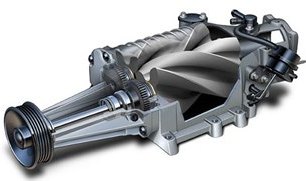 Eaton TVS (Twin-Vortices Series) is a Roots type supercharger, but it has a number of significant improvements over previous Roots superchargers. Therefore we are going to spend an extra section to discuss about it. Eaton has been the largest producer of superchargers for many years. The aforementioned Roots type superchargers on Mercedes four-cylinder engine and GM 3800 V6 were all its products. However, what really catch our attention - and would probably reverse the declining trend of superchargers - is its new TVS supercharger. It was first introduced to Chevrolet Corvette ZR1 and Cadillac CTS-V in 2008. The same year saw Audi selected it to power its new 3.0 TFSI V6. The latter is a testament of its much improved performance and refinement. Compare with the previous generation (Gen 5) Eaton superchargers, the TVS has many advantages. First of all, it can provide 20 percent higher air flow, hence higher boost and power; Secondly, it consumes less power at high rev. For example, the one on Corvette ZR1 consumes 75 horsepower at peak power, versus 115 hp on the Gen 5. This translates to higher efficiency, of course. Thirdly, it generates less heat thus depends less on intercooling. Lastly but not least, it largely eliminates the ugly noise traditionally associated with Roots-type superchargers. From mechanical point of view, the TVS has two significant changes from conventional Roots type superchargers: 1) Its rotors have 4 lobes instead of 3 lobes; 2) The twist angle of its rotors is increased from 60 degrees (on Gen 5) to 160 degrees. Let's see how these changes affect its performance. The TVS produces higher air flow because the 4-lobe rotors enable larger total volume than the old 3-lobe rotors. It's only simple geometry. Regarding accoustic quality, by doubling the tooth of drive gears, mechanical noise is lifted to higher frequency range which is less annoying to human ears. Besides, better internal air flow management reduces air noise. Regarding higher efficiency, it is contributed by two factors. The first is the larger air inlet on TVS. The illustrations below show a comparison between conventional Roots supercharger and TVS on how they go through one cycle of operation. The cycle consists of 3 phases - Expansion, Seal and Discharge. It is the Seal phase that dictates the size of air inlet. The illustration shows that the TVS can use considerably larger air inlet because its 4-lobe design reduces the span of Seal phase to 90 degrees (vs 120 degrees on the 3-lobe design). This allows the inlet to open wider. If the conventional supercharger used the same large inlet as TVS, the Seal would never happen, and the chamber would bridge between the inlet and outlet thus release all the high pressure at the outlet side. Conventional Roots Supercharger 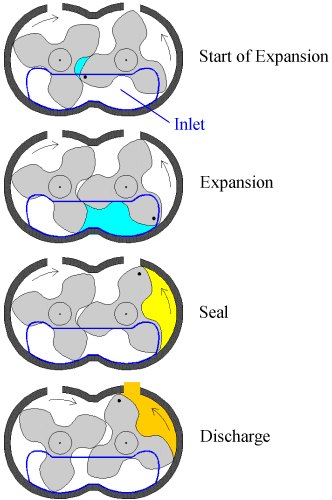 TVS Supercharger 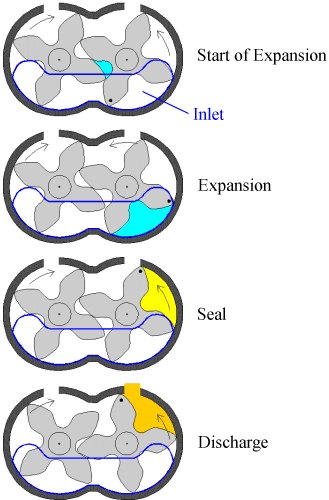 So what is the benefit of a larger inlet? The most obvious is less restriction on the rate of air flow. But we are now talking about efficiency rather than the amount of air flow, so there must be another reason... actually a very complicated reason. It takes some more explaination... To understand how it improved efficiency, perhaps we should study how a conventional Roots supercharger waste energy first. As I have mentioned, part of the energy is wasted through mechanical friction. (TVS reduces that loss by using tighter machining rotors and friction-reducing coating.) However, an even higher percentage of energy loss is due to the internal flow of the supercharger. Let's look back to the illustration above. At the start of expansion phase, you can see a new space is created between the rotors (the blue area). This space enlarges quickly (the second picture) and sucks air from the inlet to fill that space. In fact, the rotor is spinning so fast (up to 20,000 rpm) that this space enlarges at enormous speed. As a result, the part vacuum created is also enormous and the air rushes into this space at very high velocity. You can imagine what happens when this high-speed air flow hits the end of the space - it finds no way to go, then compresses, bounces back, hits the incoming air following it and causes great turbulences. Such rapid change of velocity and pressure transforms the kinetic energy to heat. In fact, Roots-type superchargers waste a lot of energy in the form of heat. It takes charge cooler and intercooler to lower the temperature, but then wasted is wasted. Now, the TVS has a considerably larger inlet. This mean the air flow goes through the inlet will be slower. Slower air flow means less kinetic energy, hence less energy is transformed to heat. Another factor contributing to its improved efficiency is the larger twist angle of rotors. With 160º twist angle, in Expansion phase the rotor takes 160º of rotation to realize full volume of chamber (blue area in picture). This mean the rate of expansion is much slower than the case of 60º twist angle, where full volume is realized with just 60º of rotation. Slower expansion reduces the part vacuum thus lowers further the velocity of intake air flow. Consequently, the aforementioned waste of kinetic energy is also reduced. Advantage Pretty high efficiency, acceptable noise. Disadvantage - Who use it ? Chevy Corvette ZR1, Cadillac CTS-V, Audi S4, Jaguar XFR, Lotus Evora S. Lysholm (screw type) supercharger 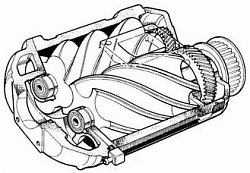 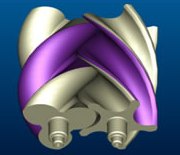 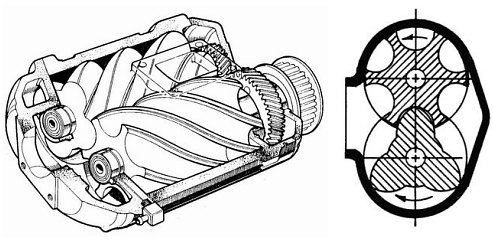 A typical Lysholm supercharger has a 3-lobe male screw and a 5-lobe female screw, though other combinations are possible. Lysholm is also called screw type supercharger. Although its theory was invented as early as 1878, it was not until 1930s that Alf Lysholm improved and realized the idea. The supercharger consists of 2 screws, one with male threads and another with female threads. They closely mesh together. When they rotate, air is captured between the screws and the housing while being pushed from the inlet towards the outlet. Moreover, the space gets smaller and smaller as it moves forward, so Lysholm performs internal compression and enables higher boost pressure than Roots type supercharger. Apart from high boost pressure, Lysholm supercharger has advantages of high efficiency, wide rpm range and compact size, so it is the first choice for performance cars. On the downside, it is very expensive to build, because the tightly meshed nature of the screws means they need very high precision machining. The high costs hampers its popularity. Few production cars are known to have it equipped, e.g. Mazda Millenium Miller Cycle, Ford GT, Mercedes-AMG's 3.2 V6 (pictured) and 5.5 V8. It is more popular in aftermarket. Many car tuners prefer to use it to boost performance. 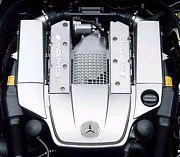 Advantage High efficiency, high boost pressure, wide rpm range. Disadvantage Expensive to build Who use it ? Mercedes "55" AMG series (including SLR), C32 AMG, Ford GT. Centrifugal supercharger 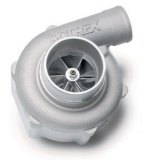 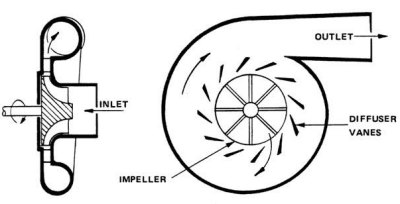 Centrifugal supercharger is very similar to turbocharger, except that it is driven by the crankshaft instead of exhaust gas. This mean it has only one turbine. Like turbochargers, its turbine needs to spin at very high speed (up to 60,000 rpm) to produce maximum boost pressure. To make this possible, it incorporates step-up gears to multiply rev from crankshaft. The boost pressure grows exponentially with rev. As a result, centrifugal supercharger produces little boost at low to medium rev. It works best at high rpm. Unlike a turbocharger which has waste gate to keep boost pressure constant at high rev, centrigual supercharger does not have such device. Therefore its output characteristic shall be designed to produce maximum boost at the engine's peak output. This also limits the boost it can provide at lower rpm. Like turbo, centrifugal supercharger uses impeller to spin the air outward by centrifugal force. Diffuser vanes guide the air flow to the outlet. The simple construction leads to advantages of lightweight and compact size. Therefore it is easy to be fitted to existing production cars as aftermarket device. Moreover, because the boost level at low rpm is negligible, the engine does not need a lot of modifications (not even reduce compression ratio) to avoid knocking. Because of its low inertia and friction, it has the highest efficiency among all superchargers. Moreover, it does not hamper the revvability of engine. On the downside, its power delivery is extremely peaky. Such characteristics can be seen on Koenigsegg supercar. Advantage Highest efficiency among mechanical superchargers, high boost pressure, small and light. Disadvantage Weak boost at low to medium rev Who use it ? Koenigsegg, Farbio. |
|
Appreciate
0
|
Post Reply |
| Bookmarks |
|
|